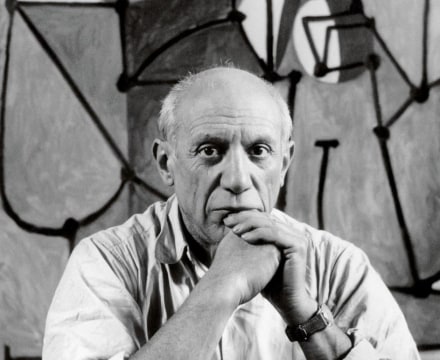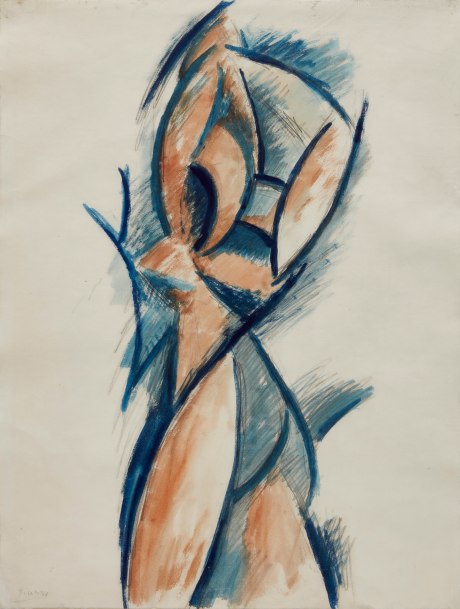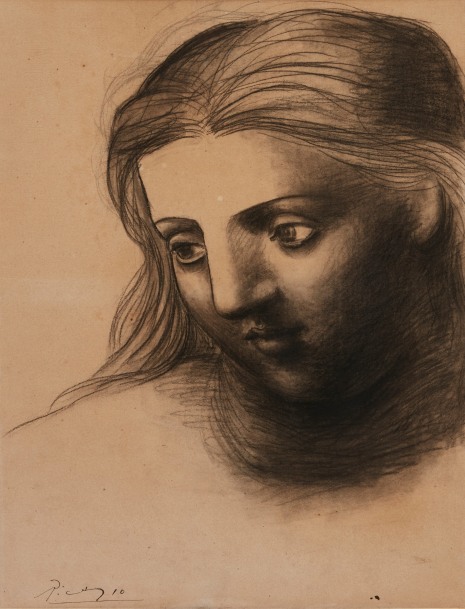
“As soon as I set to work, [other ideas] seem to flow from the pen. To know what you want to draw, you have to begin drawing it.”
- Pablo Picasso
“As soon as I set to work, [other ideas] seem to flow from the pen. To know what you want to draw, you have to begin drawing it.”
- Pablo Picasso
Exhibition Hours: Open Weekdays from 10:00am to 5:00pm and Saturdays from 11:00am to 6:00pm
Closed Thanksgiving Day
Acquavella Galleries is pleased to present PICASSO: Seven Decades of Drawing, a survey of significant drawings by painter, draftsman, sculptor, printmaker, and ceramicist, Pablo Picasso. Curated by Olivier Berggruen, the show features over 80 drawings spanning seven decades of the artist's career, including works in an array of mediums such as charcoal, crayon, colored pencil, collage, graphite, gouache, ink, pastel, and watercolor.
Drawing was the foundation of Picasso’s practice throughout the many stages of his stylistic development. The son of an art teacher, Picasso began to sketch at an early age; it is said that his first word was “piz,” short for “lápiz,” the Spanish word for pencil. He began his formal training at the age of seven, quickly mastering the techniques of classical draftsmanship.
Picasso’s drawings reflect the artist’s lifelong quest to innovate and experiment; they also demonstrate his virtuosic ability to switch between styles, techniques, and mediums. Guided by his intuition and innate understanding of line, in his drawings Picasso imaginatively experimented and pioneered the development of radical ideas, innovating new approaches to form and expression in the process.

Nu debout (Étude pour 'Trois femmes') [Standing Nude (Study for "Three Women")]
Paris, late 1907-early 1908
Watercolor and pencil on paper
25 x 19 inches (63.5 x 48.3 cm)
Private Collection
Several works on view provide insight into the evolution of his most influential, large-scale paintings, such as Les demoiselles d’Avignon, while others stand alone as virtuoso, independent works showcasing Picasso’s mastery of line, form, and medium. Developed in concert with his monumental paintings Les demoiselles d'Avignon [1907, The Museum of Modern Art, New York] and Les trois femmes [1908, The State Hermitage Museum, St. Petersburg, Russia], three drawings in the exhibition—Les demoiselles d'Avignon: Nu jaune (Étude) [1907, Collection of John and Gretchen Berggruen, San Francisco], Nu à genoux [1907-1908, The Metropolitan Museum of Art, New York] and Nu debout (Étude pour 'Les trois femmes') [1907-1908, Private Collection]—illustrate Picasso’s development of the striking, geometric female figures whose fragmented forms paved the way to Cubism. The watercolors, studies of the female form in motion, mark a radical break from traditional composition and perspective in painting. These bold and confrontational depictions of form became a seminal point in the development of Cubism and modern art.
One of the most recurring subjects in Picasso’s oeuvre is the tête de femme or buste de femme (the female head or bust of a woman). The subject serves not only as a motif to explore the artist’s stylistic development, but also to chronicle his personal life and relationships. The notorious lothario’s rapid and often dramatic changes of style are frequently attributed to the presence of a new love interest, the waning of an old one, or both. Numerous examples of the motif of the buste de femme abound in the exhibition, including early portraits evincing his study of archaic sculpture; fragmented, Cubist representations; more naturalistic, classicizing portraits; biomorphic Surrealist abstractions; and later, more erotic portraits. In his early drawing, Buste de femme nue (1906), a representation of his mistress and muse Fernande Olivier, Picasso fused Fernande’s striking face with his study of ancient Iberian masks and Romanesque sculpture, while Buste de femme (1907) betrays Picasso’s increasing interest in African masks, a formative influence in his development of Cubism. The evocative Tête de femme (1921), reflects the artist’s study of Classical sculpture and art history after World War I, when he was married to Olga Khoklova, while the sensual Portrait de femme endormie, III (1946), reflects Picasso’s later impassioned affair with Françoise Gilot and his spurring rivalry with Henri Matisse.

Tête de femme [Head of a Woman]
Fontainebleau, summer 1921
Charcoal on paper
24 x 18 1/2 inches (61 x 47 cm)
Private Collection
Seven Decades of Drawing is supported by generous loans from The Art Institute of Chicago, The Cleveland Museum of Art; Fondation Beyeler, The Metropolitan Museum of Art; The Morgan Library & Museum; The Museum of Modern Art, New York; The Museum of Fine Arts, Houston; The Solomon R. Guggenheim Museum, New York; and the Fundación Almine y Bernard Ruiz-Picasso Para el Arte (FABA), Madrid.
A fully illustrated hardcover catalogue will be produced for the exhibition featuring critical essays by historian and curator Olivier Berggruen and historian Christine Poggi.
About Pablo Picasso (1881-1973)
Arguably the most influential artist of the 20th century, over the course of his career Pablo Picasso pioneered successive artistic innovations that shaped the development of modern art. He was prolific in a wide range of mediums, including painting, drawing, sculpture, ceramics, and printmaking. Born in 1881 in Spain, the son of an art teacher, Picasso exhibited his first paintings in Barcelona at the age of 12. After an earlier trip to Paris, he left Barcelona in 1904 and moved permanently to France, where he would live until his death in 1973.
Media Contacts:
For interviews, background and images, please contact:
Abby Addams
Blue Medium, Inc
Tel: +1-212-675-1800
abby@bluemedium.com
Emily Crowley
Acquavella Galleries
Tel: +1-212-734-6400
emily@acquavellagalleries.com
All works by Pablo Picasso are © 2021 Estate of Pablo Picasso / Artists Rights Society (ARS), New York
Photo of Pablo Picasso by Robert Doisneau, 1952. Image: Gamma-Rapho via Getty Images.